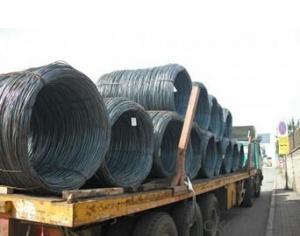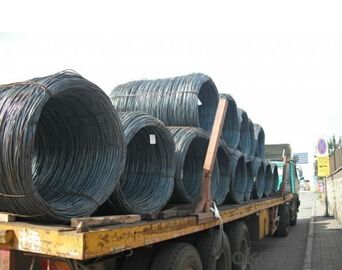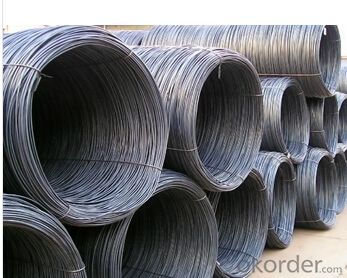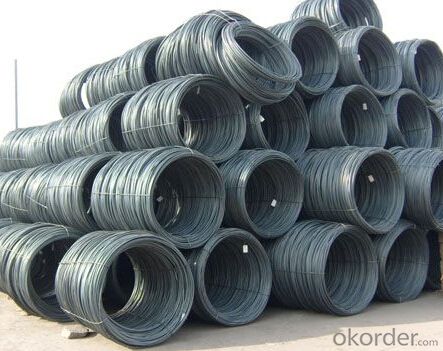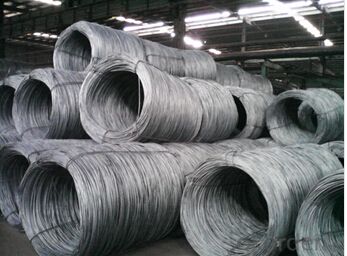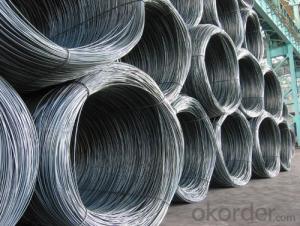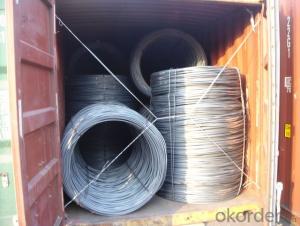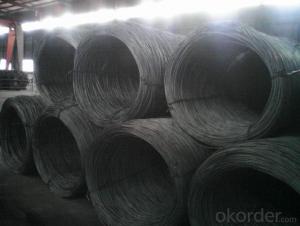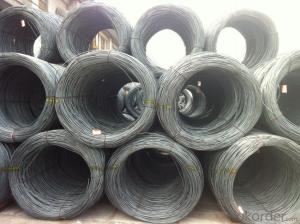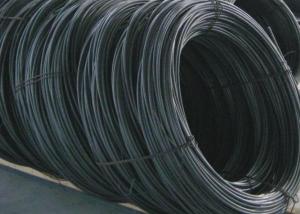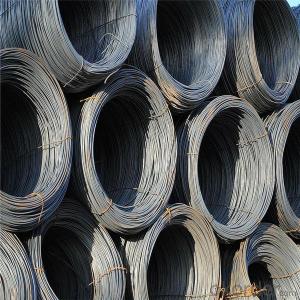Hot Rolled Carbon Steel Wire Rod
- Loading Port:
- China Main Port
- Payment Terms:
- TT or LC
- Min Order Qty:
- -
- Supply Capability:
- -
OKorder Service Pledge
OKorder Financial Service
You Might Also Like
Product Description:
OKorder is offering high quality Hot Rolled Carbon Steel Wire Rod at great prices with worldwide shipping. Our supplier is a world-class manufacturer of steel, with our products utilized the world over. OKorder annually supplies products to European, North American and Asian markets. We provide quotations within 24 hours of receiving an inquiry and guarantee competitive prices.
Product Applications:
Hot Rolled Carbon Steel Wire Rod are ideal for structural applications and are widely used in the construction of buildings and bridges, and the manufacturing, petrochemical, and transportation industries.
Hot Rolled Carbon Steel Wire Rod Advantages:
OKorder's Hot Rolled Carbon Steel Wire Rod are durable, strong, and resist corrosion.
Hot Rolled Carbon Steel Wire Rod Main Product Features :
· Premium quality
· Prompt delivery & seaworthy packing (30 days after receiving deposit)
· Corrosion resistance
· Can be recycled and reused
· Mill test certification
· Professional Service
· Competitive pricing
Specifications of Hot Rolled Carbon Steel Wire Rod:
Steel Grade: Q195/235, SAE1006-1018B Standard: ASTM, GB
Diameter: 5.5mm, 6.5mm, 7mm,8mm,9mm,10mm,12mm,14mm
Diameter tolerance: ±0.3mm Type: in coil, coil weight around 2MT
Technique: Hot Rolled
Place of Origin: China Mainland
Surface: round, no twisted, light and smooth
Chemical Composition: (Please kindly find our chemistry of our material based on Q195、Q235A and Q235B as below for your information)
Trademark | Rank | Chemical composition (quality score) % | |||||
C | Si | Mn | S | P | |||
| ≤ |
| ≤ | ≤ | |||
Q195 |
| 0.06-0.12 | 0.30 | 0.25 | 0.050 | 0.045 | |
Q235 | A | 0.14-0.22 | 0.30 | 0.30-0.65 | 0.050 | 0.045 | |
Q235 | B | 0.12-0.20 | 0.30 | 0.30-0.70 | 0.045 | 0.045 | |
Trademark | Rank | Pulling Test | |||||
Bend PointΔs/Mpa | Tensile Strength | Elongation Ratioδ5% | |||||
Thickness (Diameter) /MM | Thickness (Diameter) /MM | ||||||
≤16 | 16-40 | ≤16 | 16-40 | ||||
≥ | ≥ | ||||||
Q195 |
| 195 | 185 | 315-390 | 33 | 32 | |
Q235 | A | 235 | 225 | 375-500 | 26 | 25 | |
Q235 | B | 235 | 225 | 375-500 | 26 | 25 | |
Usage and Applications of Carbon Steel Wire Rod:
After hot-rolled the products shaped into coil and delivery as finished product, including round, square, rectangular, hexagonal and so on. Since most of the products are round, it is generally called wire rod. Carbon steel wire rod is widely used in construction and manufacturing. Carbon steel wire rod is mainly used for reinforcement of reinforced concrete and welded structure or reprocessed (roberts , nail, etc.) materials, especially used to produce wire drawing, welding electrode, nails, spring, electronic, precise machinery parts and so on.
Packaging & Delivery of Carbon Steel Wire Rod:
Packaging Detail: products are packed in coil, each coil weight around 2 MT, and then shipped by container or bulk vessel
Delivery Detail: within 45 days after received deposit or LC.
Label: to be specified by customer, generally, each bundle has 1-2 labels
Trade terms: FOB, CFR, CIF
Carbon Steel Wire Rod on Port
Carbon Steel Wire Rod in Container
Note:
1. Our products are produced according to national standard (GB), if not, supply according to national standards (GB) or agreement as customer required.
2. Other Grade and Standard carbon steel wire rod we can supply:
Grade:H08A, 30MnSi, 62B-82B
Standard: AISI, BS, JIS, DIN
The Minimum Order Quantity of these products is high, and need to be confirmed.
3. We can not only supply carbon steel wire rod; if you need anything about building materials, please contact us.
4. Please send us your detail specifications when inquire. We will reply to you as soon as possible.We sincerely hope we can establish a long stable business relationship.
FAQ:
Q1: Why buy Materials & Equipment from OKorder.com?
A1: All products offered byOKorder.com are carefully selected from China's most reliable manufacturing enterprises. Through its ISO certifications, OKorder.com adheres to the highest standards and a commitment to supply chain safety and customer satisfaction.
Q2: How do we guarantee the quality of our products?
A2: We have established an advanced quality management system which conducts strict quality tests at every step, from raw materials to the final product. At the same time, we provide extensive follow-up service assurances as required.
Q3: How soon can we receive the product after purchase?
A3: Within three days of placing an order, we will begin production. The specific shipping date is dependent upon international and government factors, but is typically 7 to 10 workdays.
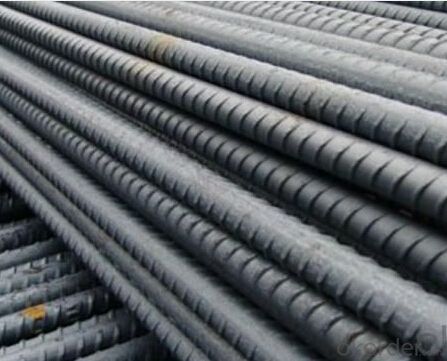
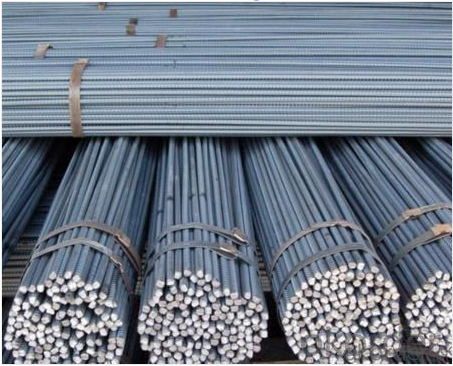
- Q: How is the surface roughness of steel wire rod controlled during manufacturing?
- The surface roughness of steel wire rods is controlled during manufacturing through various processes and techniques. One of the primary methods used is the selection of appropriate raw materials. High-quality steel with a specific chemical composition and controlled impurities is chosen to ensure a smoother surface finish. During the manufacturing process, the wire rod undergoes several mechanical treatments to achieve the desired surface roughness. These treatments include hot rolling, cold drawing, and heat treatment. Hot rolling is the initial step where the steel is heated and passed through a series of rolling mills. This process helps in reducing the surface roughness by eliminating surface defects and improving the overall surface finish. Cold drawing is another crucial step that involves pulling the wire rod through a series of dies at room temperature. This process further refines the surface finish and reduces the roughness by removing any residual scale or imperfections. Heat treatment is often employed after the cold drawing process to enhance the mechanical properties of the wire rod. It involves controlled heating and cooling cycles, which can also help in improving the surface finish by reducing any remaining surface irregularities. Additionally, surface treatments such as pickling, shot blasting, or chemical cleaning may be employed to remove any remaining oxide layers or contaminants on the surface of the wire rod. These treatments further reduce the surface roughness and enhance the overall appearance of the product. Regular quality control inspections and measurements are conducted during the manufacturing process to ensure that the desired surface roughness specifications are met. These inspections may include visual inspections, dimensional measurements, and surface roughness testing using instruments such as profilometers. In summary, the surface roughness of steel wire rods is controlled during manufacturing through careful selection of raw materials, mechanical treatments like hot rolling and cold drawing, heat treatment, surface treatments, and rigorous quality control measures. These techniques ensure that the final wire rod product has a smooth surface finish and meets the required specifications.
- Q: How does the elongation of steel wire rod vary with different wire drawing processes?
- The elongation of a steel wire rod can vary depending on the specific wire drawing process employed. Different processes, such as cold drawing or hot drawing, can impact the elongation of the wire differently. Cold drawing typically results in higher elongation as the wire is pulled through a series of dies at room temperature, causing the metal to stretch and elongate. On the other hand, hot drawing involves heating the wire rod before drawing it through the dies, which can result in lower elongation due to the higher temperature softening the metal. Additionally, the speed and force applied during the drawing process can also affect the elongation of the steel wire rod.
- Q: What are the main factors affecting the corrosion resistance of steel wire rod?
- The main factors affecting the corrosion resistance of steel wire rod include the composition of the steel, the presence of impurities or alloying elements, the surface condition and finish of the wire rod, the environmental conditions such as humidity and temperature, and the presence of corrosive agents like moisture, chemicals, or salts.
- Q: What are the major players in the global steel wire rod market?
- The major players in the global steel wire rod market include ArcelorMittal, Nippon Steel Corporation, Tata Steel Ltd., POSCO, JFE Steel Corporation, Nucor Corporation, Steel Authority of India Limited (SAIL), EVRAZ plc, Gerdau S.A., and Sohar Steel LLC. These companies are leading manufacturers and suppliers of steel wire rod, which is widely used in various industries such as construction, automotive, and manufacturing. They have a strong presence in key markets across the globe and have a significant share in the global steel wire rod market. These major players often invest in research and development to develop innovative products and improve their production processes, ensuring their competitiveness in the market. They also focus on strategic partnerships, acquisitions, and expansions to expand their market reach and strengthen their position in the global steel wire rod market.
- Q: What are the different surface treatments available for steel wire rod?
- There are several surface treatments available for steel wire rod, including galvanizing, phosphating, and coating. Galvanizing involves applying a layer of zinc to protect the steel from corrosion. Phosphating is a chemical process that forms a phosphate coating on the surface of the wire rod, providing enhanced corrosion resistance and improved paint adhesion. Coating options include powder coating, epoxy coating, and vinyl coating, which provide additional protection against corrosion and wear. These surface treatments can be chosen based on the specific requirements and intended use of the steel wire rod.
- Q: How is the steel wire rod market impacted by technological advancements?
- Technological advancements have significantly impacted the steel wire rod market by revolutionizing the manufacturing process, improving product quality, and enhancing operational efficiency. Advanced manufacturing techniques such as automation, robotics, and data analytics have streamlined production, leading to higher productivity and reduced costs. Furthermore, technological advancements in metallurgy and material science have resulted in the development of stronger and more durable wire rods, meeting the evolving demands of various industries. Additionally, innovations in wire rod coatings and surface treatments have expanded the range of applications and improved corrosion resistance. Overall, technological advancements have played a crucial role in shaping the steel wire rod market, driving growth, and enabling manufacturers to stay competitive in a rapidly changing industrial landscape.
- Q: How is steel wire rod tested for resistance to intergranular corrosion?
- Steel wire rod is tested for resistance to intergranular corrosion through various methods. One common technique is the intergranular corrosion (IGC) test, which involves subjecting the wire rod to a corrosive environment, typically an acid solution, for a specific duration. The wire rod is then visually inspected for signs of corrosion, such as cracks or grain boundary attack. Additionally, other tests like the Strauss test or Huey test may be conducted to determine the susceptibility of the steel wire rod to intergranular corrosion. These tests provide crucial information about the steel wire rod's resistance to intergranular corrosion and help ensure its quality and durability.
- Q: How does steel wire rod behave under different temperature conditions?
- Steel wire rod behaves differently under different temperature conditions. At lower temperatures, steel wire rod tends to become more brittle and prone to fracturing. This is because the cold temperatures cause the metal to contract, reducing its ductility and making it more susceptible to breaking under stress. On the other hand, at higher temperatures, steel wire rod becomes more malleable and easier to bend or shape. This is due to the expansion of the metal as it heats up, which increases its ductility and allows it to withstand greater deformation without fracturing. However, it is important to note that extreme temperatures can have adverse effects on steel wire rod. At extremely low temperatures, such as those found in cryogenic environments, the steel may undergo a phase transformation known as the ductile to brittle transition, where it becomes extremely brittle and prone to sudden failure. Similarly, at extremely high temperatures, steel wire rod may lose its strength and integrity, as the elevated temperatures can cause the metal to soften and deform. The exact temperature at which this occurs depends on the specific type of steel and its composition. In summary, steel wire rod behaves differently under different temperature conditions. It becomes more brittle and prone to fracturing at lower temperatures, while it becomes more malleable and easier to shape at higher temperatures. However, extreme temperatures can have detrimental effects on the steel's properties, leading to brittleness at low temperatures and loss of strength at high temperatures.
- Q: How is steel wire rod used in the manufacturing of wire for fishing lines?
- Steel wire rod is a crucial component in the manufacturing process of wire for fishing lines. It serves as the raw material that undergoes various processes to transform it into the desired fishing line. Initially, the steel wire rod is carefully selected based on its quality, strength, and durability. This ensures that the final fishing line will possess the necessary properties to withstand the demanding conditions of fishing. The first step in the manufacturing process involves drawing the steel wire rod through a series of dies to reduce its diameter. This drawing process is repeated multiple times until the desired thickness and diameter are achieved. This step is crucial as it determines the strength and flexibility of the fishing line. Once the steel wire rod has been drawn, it is then coated with a protective layer. This coating can be made of various materials such as nylon or polymer, which enhances the fishing line's resistance to abrasion, UV rays, and water damage. This protective layer also provides additional strength and flexibility to the fishing line. After the coating process, the steel wire rod is further processed to add specific features to the fishing line. For instance, it can be twisted or braided to increase its strength and durability. This twisting or braiding process also helps to prevent the fishing line from tangling or forming knots during fishing. Finally, the steel wire rod is cut into the desired length and spooled onto reels or packaged in smaller coils. This ensures that the fishing lines are ready for use by anglers, who can then attach them to their fishing rods and begin their fishing activities with confidence. In summary, steel wire rod plays a crucial role in the manufacturing of fishing lines. It undergoes various processes such as drawing, coating, twisting, and cutting to transform it into strong, durable, and flexible fishing lines that can withstand the demanding conditions of fishing.
- Q: How is steel wire rod used in the manufacturing of wire for safety barriers on highways?
- Steel wire rod is used in the manufacturing of wire for safety barriers on highways as it serves as the primary raw material. The wire rod is first processed and shaped into the desired gauge and dimensions, and then it is further treated to enhance its strength and durability. This processed wire is then woven or welded into the specific patterns required for safety barriers, creating a strong and reliable barrier system that can effectively prevent vehicles from crossing into opposing traffic or off the road.
Send your message to us
Hot Rolled Carbon Steel Wire Rod
- Loading Port:
- China Main Port
- Payment Terms:
- TT or LC
- Min Order Qty:
- -
- Supply Capability:
- -
OKorder Service Pledge
OKorder Financial Service
Similar products
Hot products
Hot Searches
Related keywords
